Étiquette : Mahler

Kathleen Ferrier
Brahms Alt-Rhapsodie Op.53: Chœur d’Hommes et Orchestre de la Radio Danoise (Symfoniorkestret /Statsradiofoniens Mandskor: Svend S. Schultz)
dir: Fritz Busch
2 Lieder: Von ewiger Liebe Op43-I – Wir wandelten Op96-II Phyllis Spurr, piano
Radio Studio n°1 – 6 octobre 1949 Source: 33t/LP Danacord DACO 114
___________
Mahler Kindertotenlieder: WPO Bruno Walter
Kingsway Hall 4 octobre 1949
Prod: Walter Legge/Leonard Smith – Eng: Douglas Larter
Source 33t/LP: Angel Japan EAC-57048
En l’espace de deux jours, Kathleen Ferrier nous a offert deux enregistrements majeurs.
Tout d’abord à Londres où le Philharmonique de Vienne (WPO) était présent du 28 septembre au 6 octobre 1949 au cours d’une tournée dirigée par Furtwängler qui rejoindra ensuite Paris, Genève et Zürich.
Ferrier et Walter, de retour d’Edimbourg, ont donné à Londres les 1 et 2 octobre deux concerts Mahler avec les Kindertotenlieder et la Deuxième Symphonie (BBC SO and Choral Society).
Le 4, Furtwängler a dirigé avec le WPO un concert Brahms avec Menuhin, et une séance d’enregistrement a pu être programmée l’après-midi (14h30-17h30) au Kingsway Hall pour capter les Kindertotenlieder avec Bruno Walter.
Walter dirigea un concert londonien avec le WPO le 6. Mais, ce fut sans Ferrier qui chantait ce jour-là la ‘Alt-Rhapsodie’ avec Fritz Busch à Copenhague. De toutes façons, avec le WPO à Londres, elle n’aurait pas pu chanter l’œuvre de Brahms : Furtwängler avait déjà mis la ‘Alt-Rhapsodie’ au programme de son concert du 28 septembre (avec Mary Jarred).
Le programme dirigé par Fritz Busch avec son Orchestre de la Radio Danoise comprenait la Symphonie n°7 Op.70 de Dvorak (à l’époque dénommée ‘n°2’ comme lors de sa publication), et en deuxième partie, un ou plusieurs airs de l’ ‘Orphée’ de Gluck, puis la Rhapsodie Op.53 de Brahms et enfin les Métamorphoses d’Hindemith:
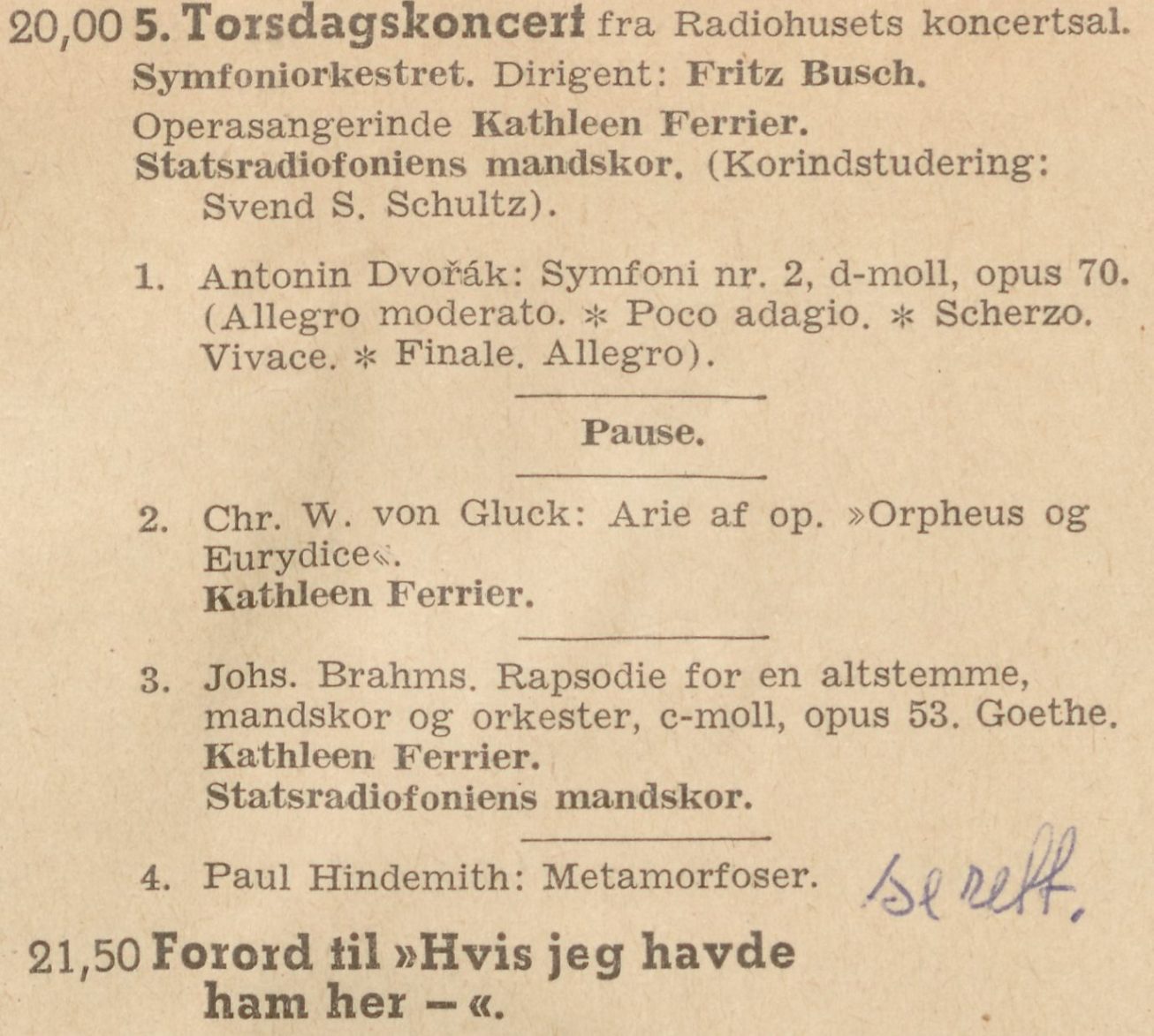
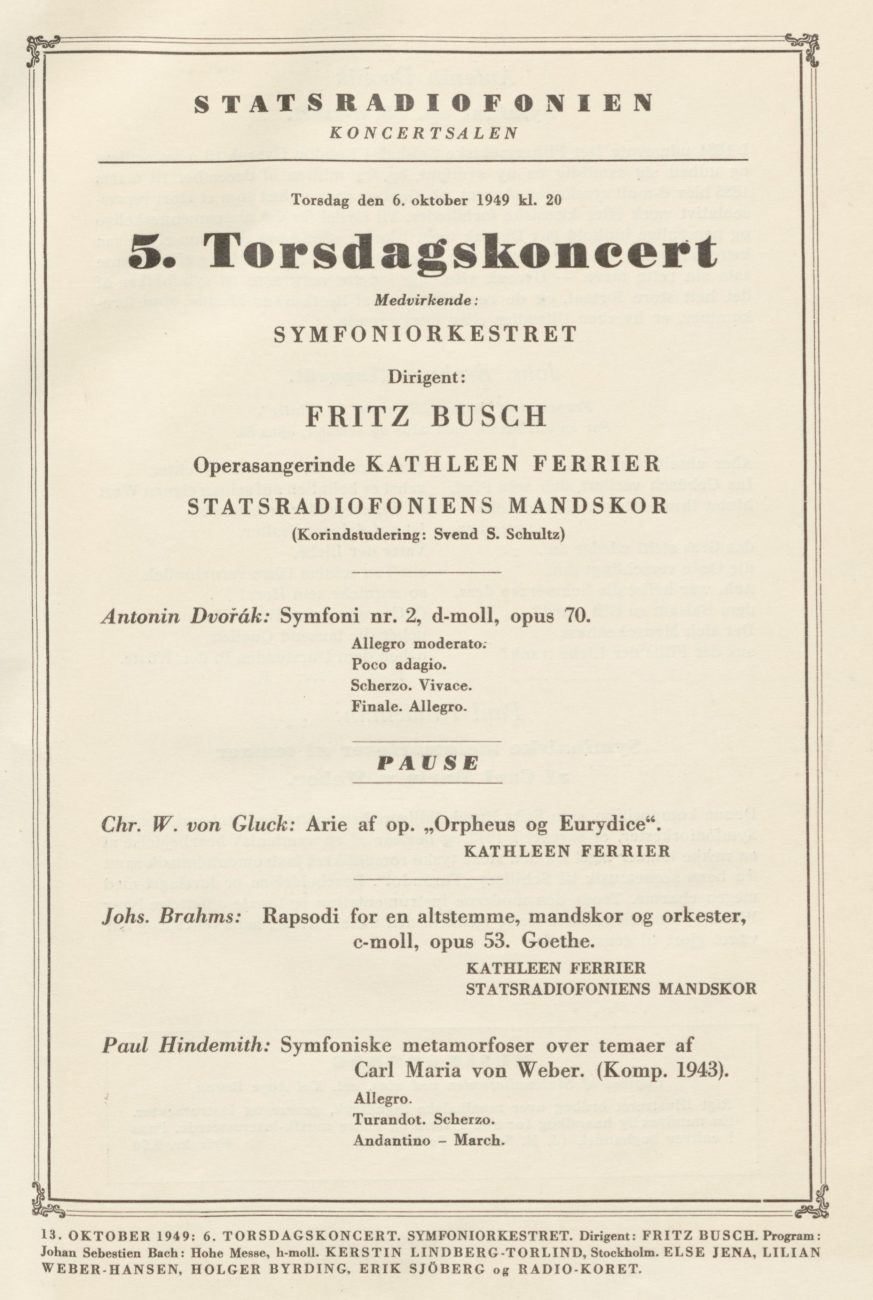
On voit que les deux Lieder de Brahms, probablement joués en bis, dans lesquels Ferrier est accompagnée par sa pianiste venue spécialement pour sa tournée en Scandinavie, ne figurent pas dans ce programme officiel. On les trouve par contre avec Gluck dans une feuille annexe de la Radio:

L’enregistrement de la Rhapsodie Op.53 a été complété par des sources provenant d’enregistrements privés de l’émission de la Radio Danoise pour compenser les parties dégradées de l’archive officielle. Les deux Lieder sont incomplets. Il manque les six premiers vers du premier Lied, et le début de l’introduction pianistique de l’autre.
Kathleen Ferrier et Fritz Busch se sont retrouvés avec l’Orchestre de la Radio Danoise au Festival d’Edimbourg, le 28 août 1950, avec le Royal Choral Union d’Edimbourg pour cette Rhapsodie Op.53.
Fritz Busch avait prévu de faire son grand retour à Berlin en mars 1952. A cette occasion, il avait invité Kathleen Ferrier à ses concerts qui devaient avoir lieu avec les 16 et 17 mars avec l’Orchestre de la RIAS. Sa disparition en septembre 1951 a réduit ce projet à néant.
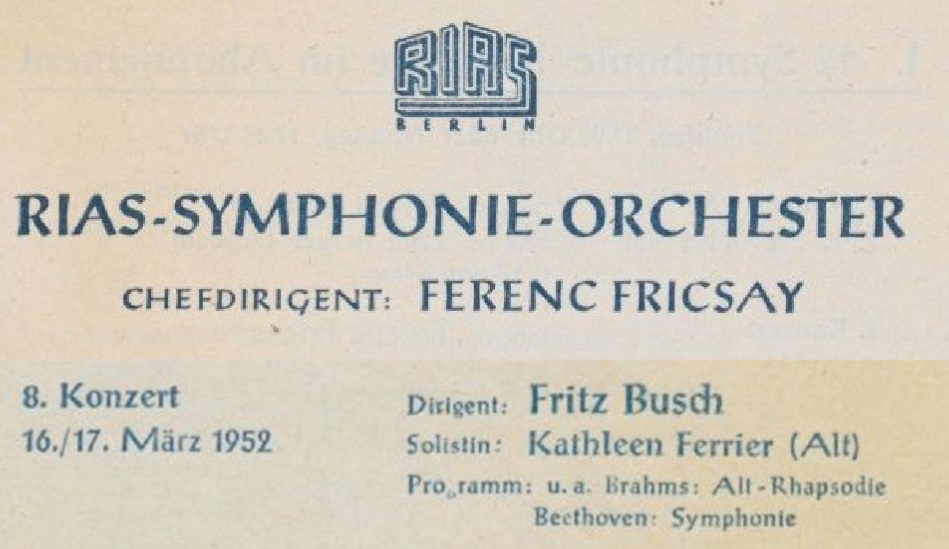
____________

____________
Within two days, Kathleen Ferrier offered us two major recordings.
To start with, in London where the Vienna Philharmonic (WPO) was present between 28 September to 6 October during a tour conducted by Furtwängler which later joined Paris, Geneva and Zürich.
Ferrier and Walter, back from d’Edinburgh, gave on October 1 and 2 two Mahler concerts in London with the Kindertotenlieder and the Second Symphony (BBC SO and Choral Society).
On the 4th, Furtwängler conducted a Brahms concert with Menuhin and the WPO, and an afternoon recording session (2.30pm – 5.30pm) has been set at Kingsway Hall to record the Kindertotenlieder with Bruno Walter.
Walter took the opportunity of being in London to conduct one concert with the WPO on the 6th. But it was without Ferrier who, on that very day, sang the ‘Alt-Rhapsodie’ with Fritz Busch in Copenhagen. Anyway, with the WPO in London, she might not have sung the work by Brahms : Furtwängler already put the ‘Alt-Rhapsodie’ at the program of his concert on 28 September (with Mary Jarred).
The programme conducted by Fritz Busch and his Orchestra of the Danish Radio was comprised of Dvorak’s Symphony n°7 Op.70 (then named ‘n°2’ as when it was published), and for the second part, Arias from Gluck’s Orpheus, then the Rhapsodie Op.53 by Brahms and to end with, Hindemith’s Metamorphosen:

We see that the two Brahms’Lieder, probably performed as encores, in which Ferrier is accompanied by her pianist who came especially for her Scandinavian tour, are not mentioned in this official programme. They are however found with the Gluck item in an extra Radio programme sheet:

The recording of the Rhapsody Op.53 was completed by private sources coming from the broadcast of the Danish Radio Danoise to compensate for the unusable parts of the official archive. Both Lieder are incomplete. The six first verses of the first Lied are missing, as well as the beginning of the piano introduction of the second.
Kathleen Ferrier and Fritz Busch met again with the Danish Radio Orchestra at the Edinburgh Festival on 28 August 1950, with the Edinburgh Royal Choral Union for this Rhapsody Op.53.
Fritz Busch scheduled his postwar return to Berlin for March 1952. He seized the opportunity for inviting Kathleen Ferrier to his concerts that were to take place on 16 and 17 March with the RIAS Orchestra. His death in September 1951 ruined this project.


Bruno Walter WPO Charles Kullman Kerstin Thorborg
Mahler: Das Lied von der Erde – Rückert Lied « Ich bin der Welt abhanden gekommen »
Wien Musikvereinsaal – «Live» 24 Mai 1936
Source: 33t/LP EMI Toshiba (Japan) EAC-57049
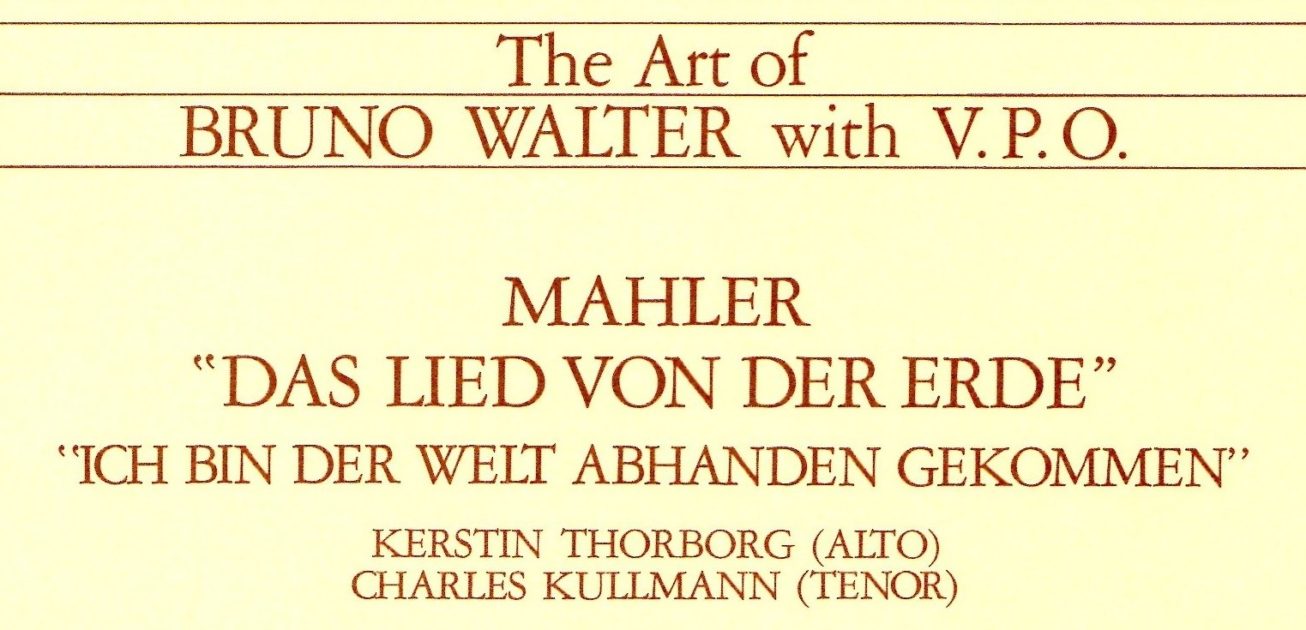
A l’occasion du 25ème anniversaire de la disparition du compositeur survenue le 18 mai 1911, Bruno Walter a dirigé trois concerts à Vienne.
Le premier a eu lieu le 22 mai dans les studios de la Radio (RAVAG) avec les Wiener Symphoniker et il a été diffusé en direct. Le programme comportait les Lieder eines fahrenden Gesellen avec Rosette Anday et la 9ème Symphonie:
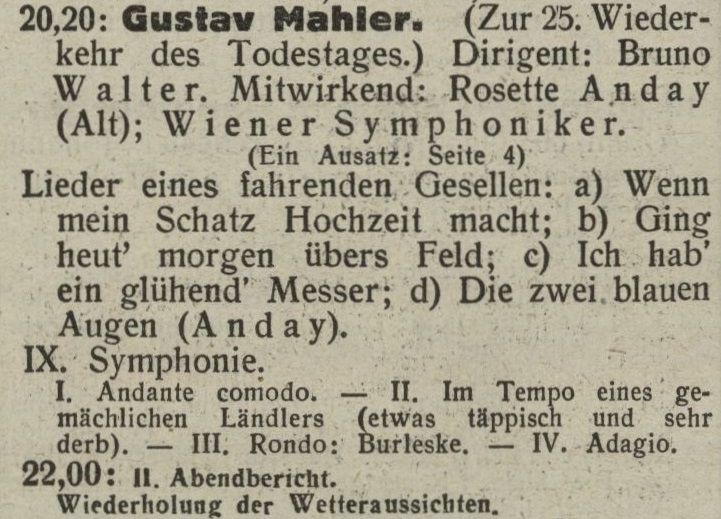
Les deux autres concerts ont été donnés les 23 et 24 mai à la Musikvereinsaal avec le WPO, Charles Kullmann et Kerstin Thorborg, avec au programme deux Rückert Lieder (Ich bin der Welt abhanden gekommen et Um Mitternacht), puis Das Lied von der Erde. Le deuxième concert a été enregistré par EMI et publié à l’exception d’ Um Mitternacht en un album ROX 165 à 171 de sept 78 tours (matrices CHAX 125 à 138) pour Das Lied von der Erde et un disque séparé LB45 (matrices CHA 744 & 745) pour le Rückert Lied.
N.B. :En 1939, Kullmann a modifié l’orthographe de son nom en Kullman.

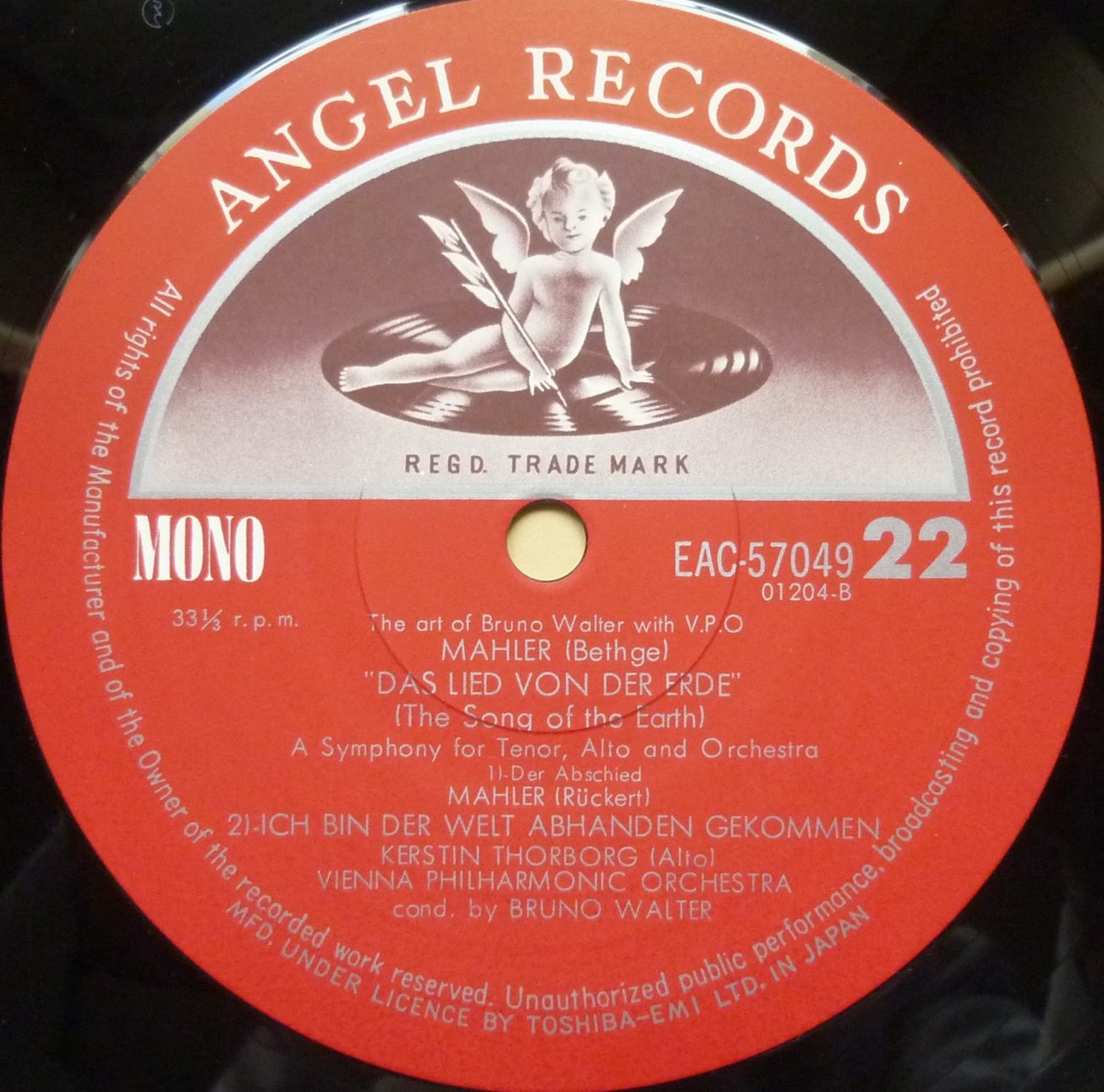
Le blog 33+45=78 qui était spécialisé dans le report de 78 tours avec un haut niveau de qualité a proposé l’enregistrement de Das Lied von der Erde avec le contenu non monté des faces 78 tours. On constate que, pour assurer une continuité sans accroc des faces 78 tours pour les Lieder (I, II, IV et VI) qui occupent plus d’une face, il y a un recouvrement de quelques secondes d’une face à l’autre.
Les fichiers mis en ligne par le site 33+45=78 sont malheureusement devenus introuvables suite à la fermeture de ce site remarquable. Ils vous sont proposés à titre de bonus.
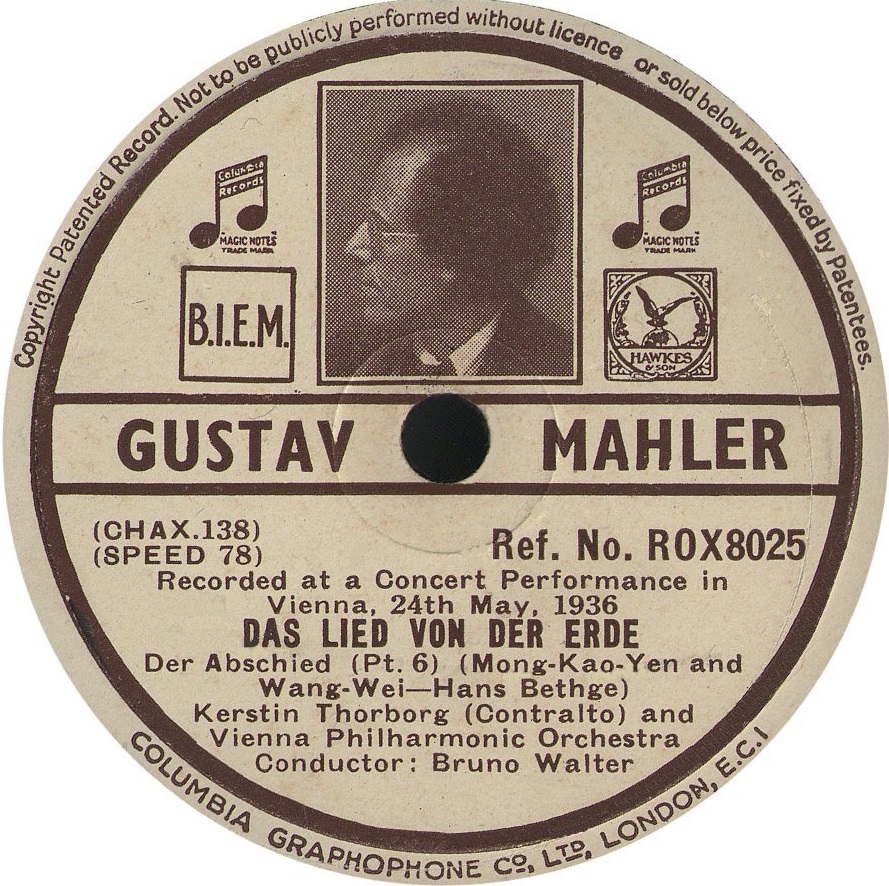
To celebrate the 25th Anniversary of the composer’s death on May 18, 1911, Bruno Walter conducted three concerts in Vienna.
The first one took place on May 22 in the studios of the Vienna Radio (RAVAG) with the Wiener Symphoniker and it was broadcast live. The program was comprised of the Lieder eines fahrenden Gesellen with Rosette Anday and of the Ninth Symphony:

The other two concerts took place on May 23 and 24 at the Musikvereinsaal with the WPO, Charles Kullmann and Kerstin Thorborg, with a program consisting of two Rückert Lieder (Ich bin der Welt abhanden gekommen and Um Mitternacht), and then Das Lied von der Erde. The second concert was recorded by EMI and published (without Um Mitternacht) as an album ROX 165 to 171 of seven 78rpm records for Das Lied von der Erde (matrix n°: CHAX 125 to 138) and a separate disc LB45 (matrix n° CHA 744 &745) for the Rückert Lied. .
N.B. :In 1939, Kullmann changed the spelling of his name into Kullman.
The blog 33+45=78 which made a speciality of high quality transfers of 78rpm records proposed the recording of Das Lied von der Erde with the unedited content of the 78rpm sides. One notes that, in order to obtain the best possible continuity between the 78rpm sides for the Lieder (I, II, IV et VI) that require more than one side, there is an overlap of a few seconds between the sides.
The files uploaded by the blog 33+45=78 are no longer available since this remarkable site closed. We propose them as a bonus.
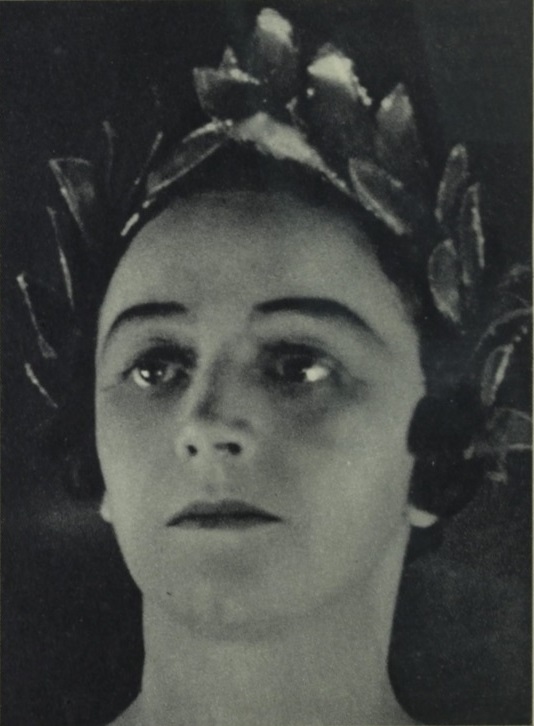
Kerstin Thorborg Orpheus Salzburg 1936
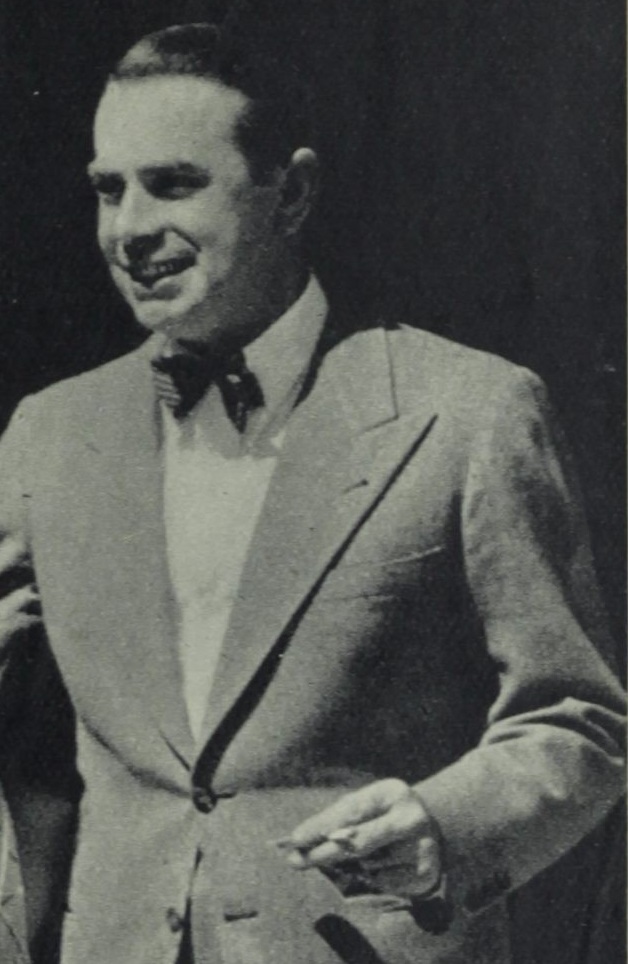
Charles Kullman Salzburg 1936
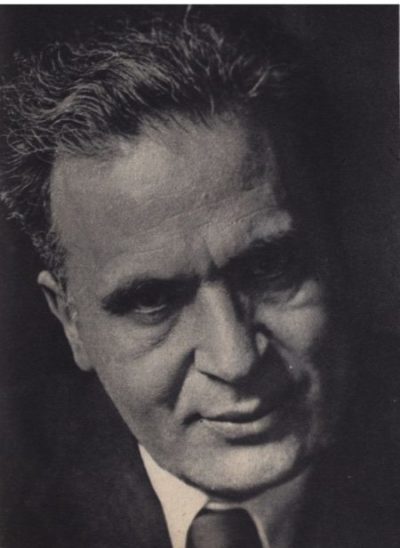
Walter – IV – Mahler Symphonie n°9 WPO
Musikvereinsaal – 16 Januar (Jänner) 1938
Source: 33t. Angel Japan « The Art of Bruno Walter with WPO »

Cette interprétation mahlérienne à la fois intense et sobre, captée en public, est un document inestimable.
En janvier et février 1938, avant de partir comme chaque année à pareille époque depuis 1933 pour une série de concerts du 3 au 19 mars 1938 avec le Concertgebouworkest d’ Amsterdam, Bruno Walter a dirigé à Vienne des concerts au Musikverein et des représentations au Staatsoper, ainsi qu’un ultime concert à Budapest, selon le calendrier suivant:
6 Janvier Staatsoper: Bizet Carmen
8 Janvier Staatsoper: Verdi Don Carlos
15 & 16 Janvier Musikvereinsaal: Mozart Symphonie n°41 – Mahler Symphonie n°9
17 Février Staatsoper: Weber Oberon
19 & 20 Février Musikvereinsaal: Mendelssohn Sommernachtstraum Ouv. – Wellesz Prosperos Beschwörungen Op.53 – Bruckner Symphonie n°4 (3 ème Version 1888)
21 Février Budapest Theatre Erkel: Mozart Symphonie n°35 – Strauss Don Juan – Bruckner Symphonie n°4 (3 ème Version 1888)
26 Février Staatsoper: Smetana Dalibor (Nouvelle production de Lothar Wallerstein Première)
Cette représentation de Dalibor de Smetana sera la dernière prestation de Bruno Walter à Vienne avant l’Anschluss et son exil forcé.

This intense and yet classical live recorded Mahler performance is an invaluable document.
In January and February, before leaving for Amsterdam like he did each year at the same period since 1933 for a series of concerts from 3 to 19 March 1938 with the Concertgebouworkest, Bruno Walter conducted in Vienna concerts at the Musikverein and at the Staatsoper, as well as a valedictory concert in Budapest, according to the following schedule:
January 6 Staatsoper: Bizet Carmen
January 8 Staatsoper: Verdi Don Carlos
January 15 & 16 Musikvereinsaal: Mozart Symphony n°41 – Mahler Symphony n°9
February17 Staatsoper: Weber Oberon
February 19 & 20 Musikvereinsaal: Mendelssohn Sommernachtstraum Ouv. – Wellesz Prosperos Beschwörungen Op.53 – Bruckner Symphony n°4 (3rd Version 1888)
February 21 Budapest Theatre Erkel: Mozart Symphony n°35 – Strauss Don Juan – Bruckner Symphony n°4 (3rd Version 1888)
February 26 Staatsoper: Smetana Dalibor (New production by Lothar Wallerstein Première)
This performance of Smetana’s Dalibor was to be Bruno Walter’s last performance in Vienna before the Anschluss and his forced exile.

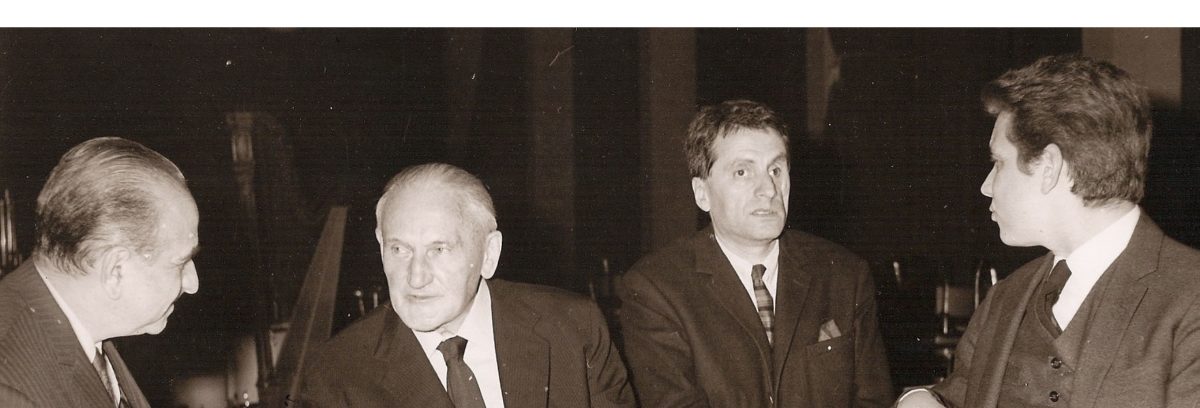
Hermann Scherchen Toronto Symphony Orchestra
Toronto Massey Hall – 22 April 1965
Source: Bande/Tape 19 cm/s / 7.5 ips
En 1965, le Toronto Symphony Orchestra a mis à son programme la Septième Symphonie de Mahler, pour en donner la Première au Canada. Le chef qui devait la diriger, Heinz Unger (1895-1965), spécialiste de Mahler établi à Toronto et bien oublié de nos jours, étant brusquement décédé le 25 février, il a été fait appel à Hermann Scherchen qui, à cette occasion, a dirigé pour la première fois au Canada.
On connaît surtout deux enregistrements de cette symphonie par Scherchen, l’un fait pour la Radio en 1950 avec le WSO, et l’autre en 1953, avec l’Orchestre du Staatsoper pour la firme Westminster. Si le premier pose des options interprétatives intéressantes, on y perçoit un manque assez gênant de répétitions, alors que le deuxième est une des meilleures versions discographiques.
Depuis cette date, Scherchen a évolué, aussi bien par ses expériences dans ses studios de Gravesano que par l’interprétation de la musique contemporaine jusqu’à Xenakis, et pour le concert de Toronto, ses réflexions l’ont conduit beaucoup plus loin. Cette interprétation tendue, à nulle autre pareille, repose sur des tempi rapides* et pousse les musiciens dans leurs retranchements, et elle propulse l’œuvre dans le XXème siècle en la rendant clairement proche de Schoenberg**. Scherchen excelle à créer dès le début du premier mouvement un climat hallucinant qu’il prolonge ensuite dans les trois mouvements nocturnes qui forment le volet central.
La retransmission du concert est précédée d’une introduction au cours de laquelle est diffusée une brève interview du chef d’orchestre par le compositeur canadien Harry Somers (1925-1999).
* Dans l’édition Bote und Bock de 1909, aussi bien que dans les programmes de concert dirigés par Mahler (Concertgebouw 2, 3 et 7 octobre 1909), Mengelberg (NYPO 8 & 9 mars 1923) et Mitropoulos (NYPO 11 & 12 novembre 1948), la partie Allegro du premier mouvement est désignée comme « Allegro con fuoco », ce qui est très différent de l’indication « Allego risoluto ma non troppo » qui est maintenant usuelle . L’interprétation de Scherchen est résolument « con fuoco »!
** Après les concerts de Mitropoulos de novembre 1948 avec cette œuvre, curieusement couplée avec le Concerto Champêtre de Poulenc avec le compositeur au piano, Olin Downes, qui en fait a quitté le concert au milieu du troisième mouvement de la symphonie, a publié dans le New York Times du 12 novembre 1948 un article au vitriol dénigrant la Symphonie de Mahler comme étant « du mauvais art, de la mauvaise esthétique et de la mauvaise musique, présomptueuse et ouvertement vulgaire ». Cet article a suscité une vigoureuse protestation de la part d’ Arnold Schoenberg qui tenait beaucoup à cette œuvre. Downes a publié cette lettre dans le numéro du 12 décembre, mais dans sa réplique, il n’a rien changé à son opinion.
____________
Pistes/Tracks:
01- Annonce/Announcement Interview Hermann Scherchen (Harry Somers)
02- I Langsam Adagio Allegro risoluto ma non troppo
03- II Nachtmusik I Allegro moderato
04- III Scherzo Schattenhaft (Fliessend, aber nicht schnell)
05- IV Nachtmusik II Andante amoroso
06- V Rondo-Finale Tempo I (Allegro ordinario) Tempo II (Allegro moderato ma energico)
07- Désannonce/Announcement
____________
In 1965, the Toronto Symphony Orchestra decided to premiere in Canada Mahler’s Seventh Symphony. The conductor who was hired to conduct it, Heinz Unger (1895-1965), a Mahler specialist living in Toronto, who is now sadly forgotten, unexpectedly died on February 25. Hermann Scherchen was called, and this was the first time he conducted in Canada.
Two recordings of this symphony by Scherchen are best known: one made for in 1950 for the Radio with the WSO, and the other one in 1953, with the Staatsoper Orchestra for Westminster. If the first one sets interesting performing options, the performance is marred by a noticeable lack of rehearsals, whereas the second one is one of the best recordings of the work.
Since that time, Scherchen has evolved, because of his experiments in his Gravesano studios as well as his interpretation of contemporary music up to Xenakis, and for the Toronto concert, his thoughts led him much further. This tense performance, which is unlike any other, is based on fast tempi* that bring the musicians to their utmost, and it propels the work well into the le XXth century, making it clearly close to Schoenberg**. Scherchen excells in creating from the start of the first movement an hallucinatory atmosphere which he further extends to the three nocturnal movements that constitute the central part.
The concert broadcast starts with an introduction including a brief interview of the conductor by Canadian composer Harry Somers (1925-1999).
* In the 1909 Bote und Bock printed score as well as in the printed concert programs conducted by Mahler (Concertgebouw 2, 3 & 7 October 1909), Mengelberg (NYPO 8 & 9 March 1923) and Mitropoulos (NYPO 11 & 12 November 1948), the Allegro part of the first movement is named « Allegro con fuoco », which is very different from the now used term « Allego risoluto ma non troppo ». Scherchen’s performance is unmistakably « con fuoco »!
** After the Mitropoulos concerts of November 1948 with this work strangely coupled with Poulenc’s Concerto Champêtre with the composer at the piano, Olin Downes, who in fact left the concert in the middle of the third movement of the symphony, published in the New York Times (November 12, 1948) a vitriolic article denigrating Mahler Symphony as being « bad art, bad esthetic and bad, presumptuous, and blatantly vulgar music ». This article fueld a vigorous protest by Arnold Schoenberg for which this work was so important. Downes published his letter in the December 12 issue, but in his response, he changed nothing to his opinion.


New York Philharmonic – Bruno Walter – Irmgard Seefried, soprano
Carnegie Hall – 4 janvier 1953
Source: Bande/Tape 38 cm/s / 15 ips
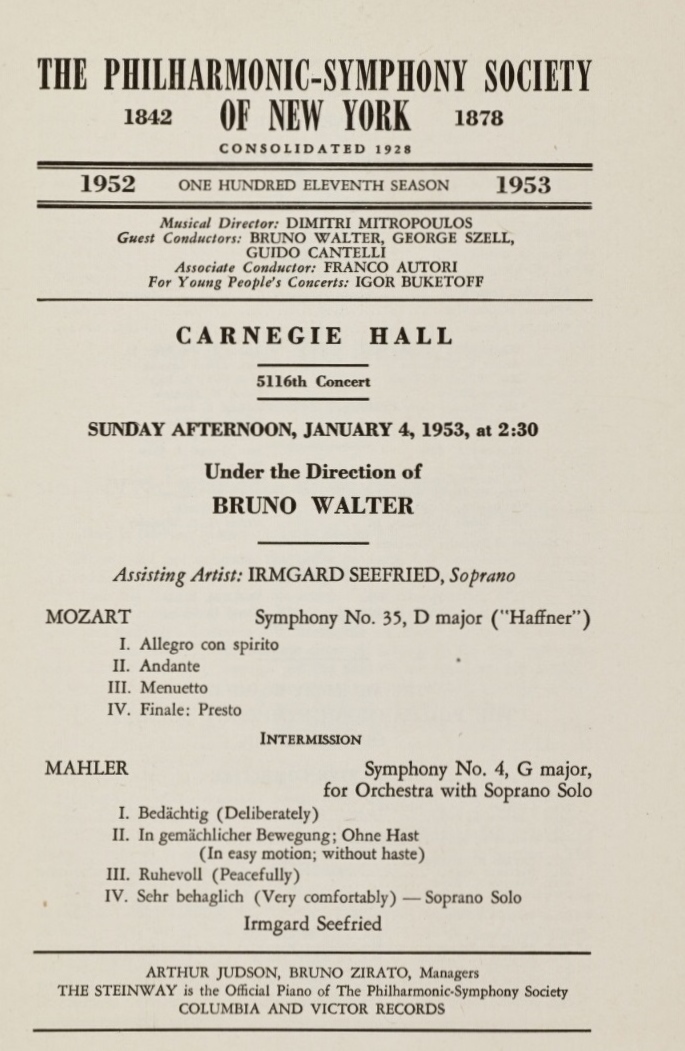

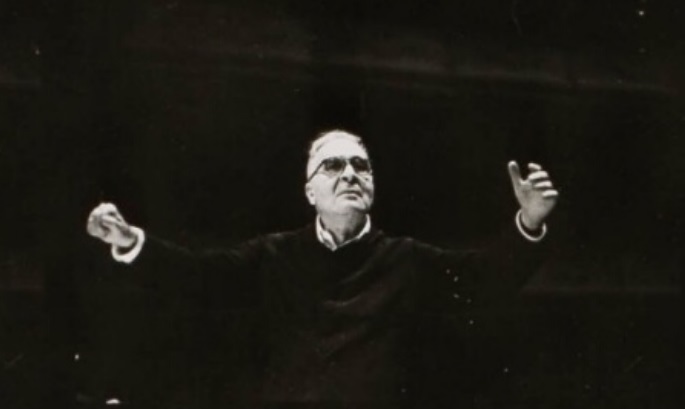
Irmgard Seefried a chanté pour la première fois avec Bruno Walter au Festival de Salzburg 1950, les 23 et 24 août, avec au programme cette même Quatrième Symphonie qu’elle a aussi donnée sous sa direction au Festival d’Edinburgh le 22 août 1951 lors de son tout premier concert avec le NYPO. Sa première apparition à New York a été un récital à Town Hall le 9 décembre 1951 avec Paul Ulanowsky, lors de sa première tournée américaine.
Le concert radiodiffusé du dimanche 4 janvier ne comportait pas les mêmes œuvres que les deux précédents, donnés les 1er et 2 janvier* qui proposaient quatre Lieder avec orchestre de Mahler (Ich bin der Welt abhanden gekommen, Wo die schönen Trompeten blasen, Ich atmet’ einen linden Duft, Wer hat dies Liedlein erdacht), des premières pour le NYPO, dont on n’a hélas pas l’enregistrement, ce qui est d’autant plus regrettable que ce sont les seuls concerts où Seefried et Walter les ont programmées:
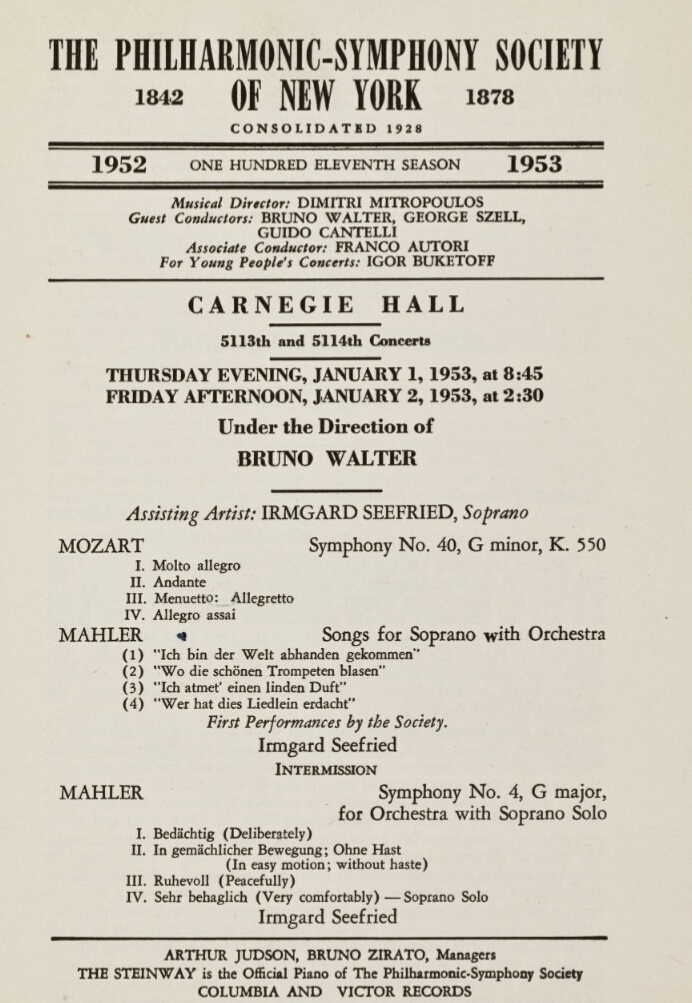
* le concert du 3 janvier 1953 a été dirigé par Franco Autori avec un tout autre programme (Debussy Cathédrale Engloutie, Beethoven Concerto n°5 Eugene Istomin, Sibelius Symphonie n°2).
§§§§§
Seefried a déclaré en 1982 dans une interview: « J‘ai appris de Bruno Walter le style de Mahler. Il m’a dit que Mahler était quelqu’un de très sérieux et de très strict, qu’il fallait le chanter de manière claire et classique, et que pour le Final de la Quatrième, je devais avoir le sentiment d‘être un petit ange chérubin avec une petite trompette, alors que la plupart des sopranos le font comme une petite berceuse ».
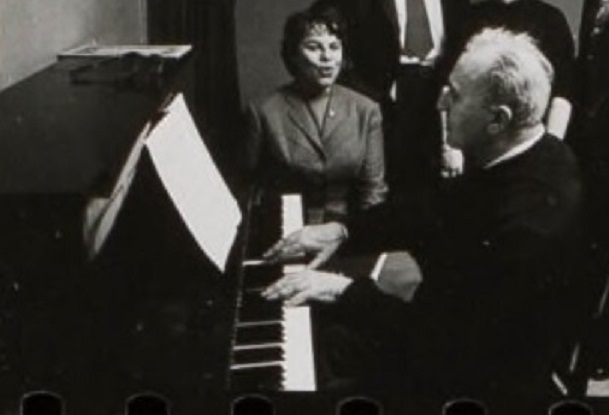
Il reste à expliquer pourquoi, lors du concert du dimanche, la Symphonie n° 35 « Haffner » de Mozart (17′) a été jouée au lieu des quatre mélodies de Mahler (durée totale 15′) qui auraient été le choix logique. L’explication est qu’une séance d’enregistrement était programmée le lundi 5 janvier, dans les Studios Columbia avec la Symphonie « Haffner » et …… « Siegfried Idyll » de Wagner. Il n’est guère étonnant qu’au vu de la charge de travail de l’orchestre en ce début d’année, la séance du 5 janvier ait été peu productive et que l’essentiel de ce qui a été publié provienne de la séance supplémentaire programmée à la hâte le 16 janvier (Mozart Symphonie n°35: 16 janvier; Wagner Siegfried Idyll: 5 & 16 janvier), organisée alors même que l’orchestre donnait ce jour-là en début d’après-midi un concert sous la direction de George Szell.
____________
Irmgard Seefried sang for the first time with Bruno Walter at the 1950 Salzburg Festival, on August 23 and 24, and it was this Fourth Symphony which she also sang under his direction at the Edinburgh Festival on August 22, 1951 for her very first concert with the NYPO. During her first US tour, she was heard at a Town Hall recital with Paul Ulanowsky on December 9, 1951, and this was the first time she sang in New York.
The Sunday January 4 broadcast was not comprised of the same works as the two other ones on January 1 and 2* which proposed four Mahler orchestral Lieder (Ich bin der Welt abhanden gekommen, Wo die schönen Trompeten blasen, Ich atmet’ einen linden Duft, Wer hat dies Liedlein erdacht), first performances with the NYPO, and there is unfortunately no recording thereof, which is all the more regrettable since these were the only concerts at which Seefried and Walter performed them.
* the January 3, 1953 concert was conducted by Franco Autori with an entirely different program (Debussy Cathédrale Engloutie, Beethoven Concerto n°5 Eugene Istomin, Sibelius Symphonie n°2).
§§§§§
In a 1982 interview, Seefried declared: « I learned the style of Mahler from Bruno Walter. He told me that Mahler was somebody very serious, very strict, that he had to be sung in a clear and classical way, and that for the Final movement of the Fourth, I was to have the feeling of being a tiny Cherubino angel with a tiny trumpet, whereas most sopranos do it as a little lullaby« .
There remains to explain why, at the Sunday broadcast concert, Mozart’s Symphony n° 35 « Haffner » (17′) has been played instead of the four Mahler Lieder (total timing:15′) which would have been the logical choice,. The reason was that a recording session had been scheduled on Monday January 5) at the Columbia Studios with the « Haffner » Symphony and…… Wagner’s « Siegfried Idyll ». Small wonder that, in view of the orchesta’s workload on this first week of 1953, the January 5 session had not been very successful, and that the major part of what has been published came from the hastily organized additional session on January 16 (Mozart Symphony n°35: January 16; Wagner Siegfried Idyll: January 5 & 16) scheduled although the orchestra was giving that very day an afternoon concert with George Szell.
Les liens de téléchargement sont dans le premier commentaire. The download links are in the first comment.



